Singing bowls can have a powerful positive impact on the chakras. In this post, we explain the benefits that singing bowls can have on the chakras, discuss which types of singing bowls correspond to the different chakra notes, and describe some ways to align or heal chakras with singing bowls. Let's dive in!
Introduction
Tibetan singing bowls, or simply singing bowls, are great tools for meditation. Singing bowls have been used in Buddhist traditions for hundreds of years and have gained popularity in the Western World in the past few decades. Most commonly, singing bowls are used to guide meditation or accompany yoga in the West, but there are many different, beneficial uses of singing bowls. One use that practitioners of singing bowls have found is that singing bowls possess the ability to treat and realign chakras. This guide is for anyone interested in learning more about the special relationship between chakras and Tibetan singing bowls.
This guide covers the following subjects:
- What are chakras?
- What are the different kinds of chakras?
- How do chakras relate to singing bowls?
- What are the benefits that singing bowls can have on chakras?
- What types of singing bowls correspond to the different kinds of chakras?
- What are some ways to align or heal chakras with singing bowls?
- Chakra awareness meditation
- How to balance chakras
- How to use a chakra singing bowl set
What are Chakras?
Perhaps you have just recently purchased a singing bowl and are researching the various ways and methods singing bowls can improve your life and you’ve come across the link between chakra healing and singing bowls. You may have read that singing bowls and their notes can heal chakras, but you may or may not be familiar with what chakras are. If that is the case, let’s first begin by discussing what chakras are.
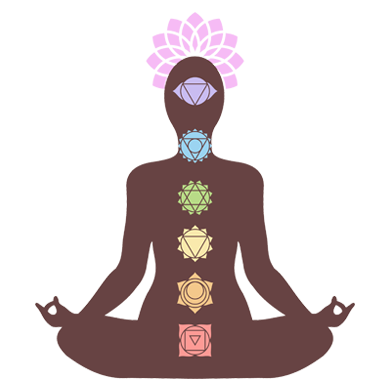
Photo Credit: The Law of Attraction
Chakras are energy centers located in certain parts of your body. Chakras originate in Hindu and Buddhist traditions and date back as far as 1,000 B.C.E.. Thousands of years later, the concept of chakras has transcended its humble beginnings and is now recognized across many different cultures and countries. There are seven primary chakras, or seven energy centers, located along the center channel of the body, commonly thought of as the spine. While these seven chakras are the most recognizable of the chakra system within us, there are hundreds of these energy centers elsewhere in the body and around the body’s energy field. The seven chakras are present to facilitate a harmonious flow of energy within our bodies, while subtle body/minor chakras play a much subtler role.
The seven primary chakras are ordered by color and have associations with specific elements, symbols, gemstones and musical notes. When these chakras are working together in a healthy flow of energy, you should feel like the best version of yourself. Unobstructed chakras are associated with good health and well-being. However, when one or more of these energy centers are out of balance or blocked, this is when you might find yourself with a great number of emotional, mental or physical problems. Singing bowls are said to balance and unblock these chakras, restoring balance within the body. When using singing bowls to cleanse your chakras, it is very important to know which chakras are affected so that you can better focus your healing on specific chakras.
What are the Different Kinds of Chakras?
As stated previously, there are seven main chakras. These chakras will be the focus of our discussion about singing bowls, but remember that most literature identifies hundreds of chakras within our bodies and around us.
Root Chakra
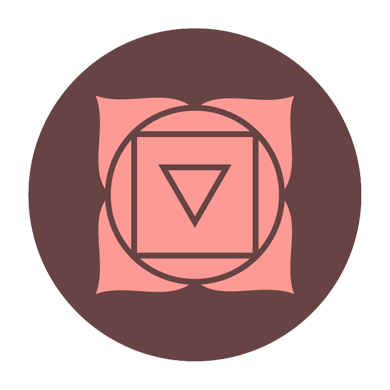
Photo Credit: The Law of Attraction
The Root chakra, also called the First or Base Chakra, can be found at the base of the spine. This chakra is related to our emotional and mental stability. When this chakra is aligned, we feel more grounded and have more trust in the world. It is also associated with prosperity and health. When this chakra is out of balance, you may feel afraid, anxious or fatigued. Physical ailments that may arise when you root chakra is out of balance include bowel and intestinal issues, depression and back issues. This chakra can become blocked or unbalanced if something threatens your basic survival needs. The corresponding element to the root chakra is earth and its corresponding gemstones are obsidian and garnet. It is associated with the color red and the musical Note C.
Sacral Chakra

Photo Credit: The Law of Attraction
The Sacral Chakra, also known as the Second Chakra or the Sexual Chakra, is located in the middle of the abdomen between the navel and the pubic bone. Not only does this chakra relate to your sexuality and relationships, but it is also key to your creativity. A balanced sacral chakra brings about creative inspiration and passion to create not only art, but improve your relationships and connections with others. When this chakra is out of balance, you may experience boredom and frustration or feel uninspired. You may also struggle emotionally in your relationships. Physical symptoms of a blocked sacral chakra include low sex drive, reproductive issues and urinary discomfort, which is why sacral chakra healing can be so important. The sacral chakra can become misaligned if you are in an unsatisfying relationship. The corresponding element to the sacral chakra is water and its corresponding gemstone is carnelian. It is associated with the color orange and the musical Note D.
Solar Plexus Chakra
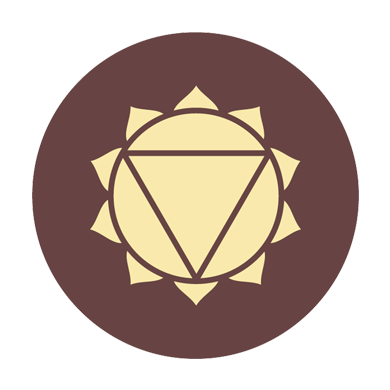
Photo Credit: The Law of Attraction
The Solar Plexus Chakra, or Third Chakra, is located in the upper abdomen, between the breastbone and the navel. This chakra is sometimes called the “personal power” chakra because it is associated with our emotions, self-esteem, autonomy and determination. When this chakra is balanced and unblocked, we feel more empowered and have a clearer view of our future successes. When this chakra is blocked or unbalanced, you may experience poor self-esteem or overcompensate your lack of confidence by being overly aggressive and dominant. Physical symptoms may include digestive and stomach issues. This chakra can become misaligned if you experience failure or unpleasant social interactions. The corresponding element to the sacral chakra is fire and its corresponding gemstones are citrine and topaz. It is associated with the color yellow and the musical Note E.
Heart Chakra
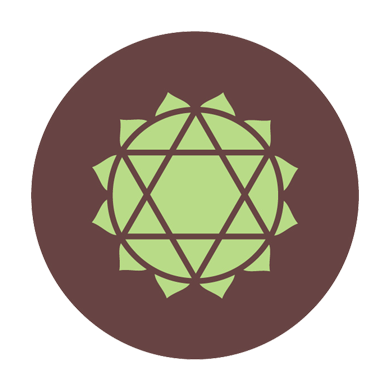
Photo Credit: The Law of Attraction
The Heart Chakra is located in the center of the chest. As the name might suggest, the heart chakra is related to compassion, friendship and empathy. It also governs our ability to create more love in our lives. When this chakra is working properly, we can experience more love and peace within ourselves and the people around us. When the heart chakra is blocked or unbalanced, our relationships with others suffer because we’ll often struggle to relate or empathize with them. Physical symptoms of a misaligned heart chakra include high blood pressure and a weak immune system. The corresponding element to the heart chakra is air and its corresponding gemstones are aventurine and rose quartz. It is associated with the color green, though sometimes it may be shown as pink, and the musical Note F.
Throat Chakra
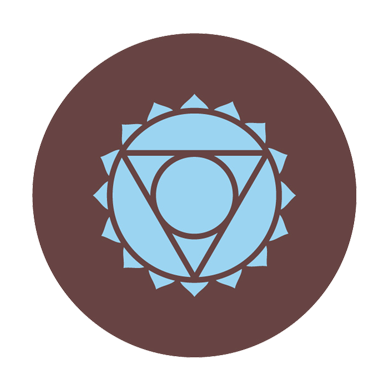
Photo Credit: The Law of Attraction
The Throat Chakra is located at the base of the throat. This chakra is often associated with our ability to communicate, express ourselves and speak our truth. When the throat chakra is in perfect balance, your communication with others will be effective and efficient. However, when the throat chakra experiences misalignment, you may struggle with keeping secrets or not be able to express yourself clearly. Physical symptoms of a blocked throat chakra include pain in the neck, sore throats, stuttering or mouth ulcers. Instances of poor communication, such as a bad interview or argument, can shift the throat chakra. The corresponding element to the throat chakra is ether and its corresponding gemstone is azurite. It is associated with the color azure blue and the musical Note G.
Third Eye Chakra
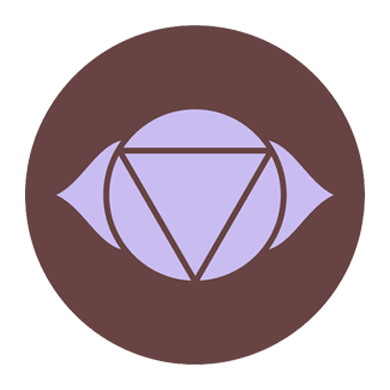
Photo Credit: The Law of Attraction
The Third Eye chakra, also called the Ajna center, is located in the center of the forehead between the eyebrows. This chakra relates to our ability to understand and visualize the bigger picture in life. It governs our intuition and potential psychic abilities. Unlocking or balancing the third eye chakra nurtures intuitive ability and improves memory and imagination. When your third eye chakra is blocked or unbalanced, you may experience feelings of worthlessness or doubt yourself. Additionally, you may have trouble sleeping and struggle with learning new things. The corresponding element to the third eye chakra is extrasensory perception (ESP) and its corresponding gemstone is lapis lazuli. It is associated with the color indigo blue and the musical Note A.
Crown Chakra
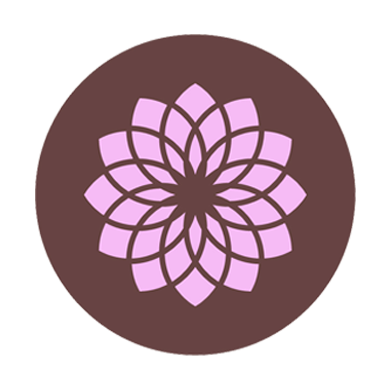
Photo Credit: The Law of Attraction
The final primary chakra is the Crown Chakra, sometimes called the Head Chakra or “thousand petal lotus” chakra. The crown chakra can be found at the top of the head. It is associated with spirituality, cosmic awareness and wisdom. The highest of the chakras, the crown chakra is responsible for creating a life you love and achieving inner peace. A balanced crown chakra allows you to be in harmony with your life and the world around. You will be more thoughtful and be better prepared to face life’s challenges. A crown chakra that is unbalanced or blocked may cause you to feel lost, confused and depressed. Physical ailments associated with a blocked crown chakra include chronic headaches and fatigue. The corresponding elements to the crown chakra are thought and pure light; its corresponding gemstone is amethyst. It is associated with the color violet and the musical Note B.
Subtle and Minor Chakras
Subtle body and minor chakras are chakras inside our bodies and around our energy fields (in addition to the seven primary chakras). There are several layers of vibrating energy that make up the energy fields around us and each of these levels contain a number of subtle body chakras. Some important subtle body chakras to note are:
- Om Chakra
- High Sacral Chakra
- High Heart Chakra
- Soul Chakra
- Soul Star Chakra
These chakras are associated with many different things, from spirituality to clairvoyance. Subtle and minor chakras tend to correspond with musical scales with sharp key signatures. For example, the Om Chakra is cleansed with Note C#, while the Soul Chakra corresponds with the Note G#. These chakras do not function the same way the primary chakras do. You may find that focusing on balancing just the seven primary chakras is a better use of effort and time as these chakras have a greater affect on your health and well-being.
What are the Benefits that Singing Bowls Can Have on Chakras?
As we noted above, singing bowls possess the ability to realign or heal chakras. This is because each of these energy centers has a “unique vibrational frequency.” These frequencies can interact with the vibration frequencies that are created when playing a singing bowl. Like any musical instrument, Tibetan singing bowls rely on friction and vibration, like striking or rimming the bowl with a mallet, to create sound. According to Jevon Dängeli, an Authentic Self Empowerment (ASE) Facilitator and Trainer, the sound waves created when one plays a singing bowl interact with the unbalanced chakras causing them to self-correct. Chakra balancing with singing bowls restores a “harmonious flow of energy” to the chakra system in a natural and calming way.
What Types of Singing Bowls Correspond to the Different Kinds of Chakras?
Crystal singing bowls are often the type of singing bowls associated with chakra healing. However, you will find that many different types of singing bowls will help tune your chakras. The type of singing bowl you need can also depend on the chakra that needs healing. Some specialists believe that specific tones work for specific chakras. In the section about chakras, each chakra was listed with a particular musical note. Most practitioners work with the C major scale, which has seven notes, each of which corresponds to one of the primary chakras. Additionally, there are other musical scales that contain more notes that correspond with subtle body chakras.
If you know which chakra needs balancing, you can select a bowl that corresponds with this chakra. It is generally believed that lower tones work for lower chakras and higher tones work for higher chakras. For example, if your crown chakra is blocked (the highest chakra), the note B (the highest pitch on the C major scale) should be played. There are many singing bowls available that are tuned to specific notes on the C major scale, making it possible to purchase a singing bowl for each chakra individually or in a set.
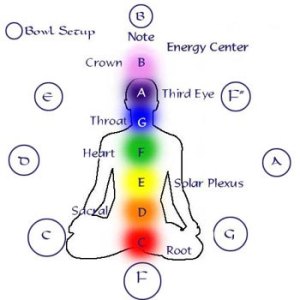
It is also possible to heal chakras without the use of specifically toned singing bowls or a chakra set. While corresponding tunings may target specific chakras more effortlessly, any singing bowl can be used with chakras as long as you are intentional with your playing and meditation. As long as you believe that there is a relationship between singing bowls and chakras, this creates an environment that allows healing to occur. Another general rule if you are not in the market for a specifically tuned bowl is to remember that higher chakras respond to higher pitches and vice versa. Smaller singing bowls, such as Manipuri or Remuna bowls, tend to produce higher pitches. Larger singing bowls, like Jambati or Ultabati bowls, produce lower pitches. Keep this in mind when selecting a singing bowl to balance your chakras.
What are Some Ways to Align or Heal Chakras with Singing Bowls?
As we have already discussed, if one or more chakras are unbalanced or blocked, they can cause a troublesome amount of mental, emotional and physical problems. This is why there are many practices, methods and meditations available for those wishing to realign their chakras. When first learning to balance chakras with singing bowls, it is important to note that it may take practice and patience before you are able to heal your chakras.
Chakra Awareness Meditation
The best way to restore harmony to your chakras with singing bowls is through Chakra Awareness Meditation. This meditation allows you to discover and pinpoint which chakras are unbalanced or blocked. To begin, create a quiet, relaxed environment through the use of candles, calming scents, soft lighting and whatever else makes you feel comfortable and relaxed. You may also want to incorporate gemstones in the environment. It may help to have present the corresponding gemstones that each chakra is associated with. Sit or lie down comfortably but maintain an aligned and straight spinal column. Start by relaxing your body, taking deep breaths and clearing your mind.
Once you are fully relaxed, focus on the location of the first chakra, the root chakra, at the base of your spine. Observe the energy in this area. What is happening there? Is energy flowing? Is it a small center of energy or a large one? How is it moving? Once you feel that you have an understanding of the state this chakra is in, move on to the next chakra, the sacral chakra, and repeat this process. Observe each chakra in this manner, moving from lowest to highest chakra. It may be helpful to take notes on what you see.
How to Balance Chakras
After completing the Chakra Awareness Meditation, you may have discovered that one or more of your chakras are misaligned or blocked. Therefore, you are now ready to begin balancing your chakras with a singing bowl. The singing bowl can be played by yourself or by another person who is assisting your healing. If another person is helping you or you are helping another person, the individual tuning their chakras should lie comfortably on the floor or bed. Avoid using any pillows, as pillows elevate your head and lift it out of alignment with the spine. If you are alone, sit or lie comfortably with easy access to your singing bowl.
Begin playing your singing bowl by either striking it with a mallet three times or rubbing the mallet around the rim to create resonance. Then, similar to the Chakra Awareness Meditation, focus on the specific chakra that needs healing. Visualize the way this chakra will heal: fill it with light or love. Imagine that the energy center is warming up in the light. Envision the energy or the vibrations aligning along your spinal column. Take as much time as you need. Once you are satisfied with your visualization, move on to the next chakra that needs your attention or end the meditation. If you wish to heal or realign each primary chakra, repeat this process with each chakra starting with your lowest chakra, the root chakra, and making your way up to the highest chakra, the crown chakra. Once reaching the crown chakra, you can then work your way back down and end on the root chakra.
This is just one way of meditating and healing chakras with your singing bowl. There are other methods of playing your singing bowl or meditating that might work better for you. There are also meditation practises that recommend placing your singing bowl on your body near the location of the chakra and playing it there. The vibrations shared between the skin and the bowl can be quite healing, though please refer to our guide about the dangers of singing bowls before placing a singing bowl on your body. Regular chakra cleansing sessions with your singing bowl can be done daily if you wish.
Remember that there is no wrong way to do this type of healing—as long as you are intentional and open to healing, you are doing it right.
How to Use a Chakra Singing Bowl Set
Finally, it is possible to balance your chakras with a chakra singing bowl set, also known as chakra bowls. In this case you will need seven singing bowls, each of which are tuned to one of the seven notes on the C major scale. Before meditating and visualizing, play the specific bowl that corresponds to the chakra you are cleansing. Between each chakra, allow the sound of the previous singing bowl to fade away or gently place your hand on the side of the bowl to stop the resonance before playing the next bowl. Some people find that singing bowl sets work great when wanting to make body contact with the bowl. The seven different chakra singing bowls can be placed on or around your body and played by someone assisting you.
Conclusion
Chakras are potent energy centers that have the power to allow or prevent you from being your best self. One way to live a fulfilling and healthy life is to meditate and keep these chakras balanced and unobstructed. Purchasing and playing a singing bowl is a perfect and natural way to correct misaligned chakras within the body. We hope that this guide has been informational and has provided a better understanding of the special relationship between singing bowls and chakras.
We invite you to get your own Tibetan singing bowl or crystal singing bowl today! Happy playing and happy healing!

Photo Credit: Shanti Bowl
Did You Enjoy This Article?
Thank you for reading! If you enjoyed this article, you might also like the following articles: Sound Baths: The Complete Guide and Guided Meditation with a Tibetan Singing Bowl

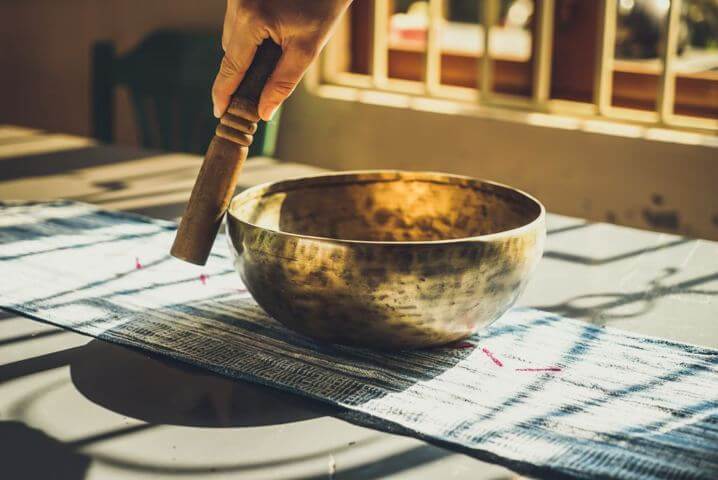
20 comments
Mar 23, 2021 • Posted by Shanti Bowl
Hi Cher, thanks for your question! One great way to check is to use a musical tuner. There are apps available on your phone which you can download for that purpose. Using a musical tuner will help you determine the nature of the sound you are playing. As for the other part of your question, sometimes the text on singing bowls will indicate the nature of the sound emitted by the bowl, but often it is just decoration. We hope that helps!
Mar 23, 2021 • Posted by Cher
How do you know if you’re hitting the right note if you’re not familiar with them? Also, do the symbols on the bowl correspond to specific chakras or notes?
Thank you!
Mar 01, 2021 • Posted by Shanti Bowl
Hi Lynda, thanks for your question! The color of the bowl is not essential, but we recommend using a naturally-colored bowl as this is most authentic and connected to nature and the chakras. We offer some great naturally-colored metal and crystal bowls. Click the “shop” button on the menu at the top of this page to see them. We hope this helps and please let us know if you have any questions!
Mar 01, 2021 • Posted by Lynda
Does it matter what color the bowl is? For the throat chakra in the G note
Feb 17, 2021 • Posted by Shanti Bowl
Hi Pat, thanks so much for your question! For those wanting a very high quality bowl at an affordable price, we recommend our 5’5 inch Tibetan singing bowls. We intentionally price them much lower than comparable bowls at other stores so that we can make singing bowls more accessible to everyone regardless of their means. Please click the “shop” button in the menu above to check out the bowl! Please let us know if you have any questions!
Feb 17, 2021 • Posted by Pat
What size bowl is a good size?
The bowls are expensive, would like to know the size that is affordable for myself and family?
Thank You
Feb 01, 2021 • Posted by Shanti Bowl
Hi Den, thanks so much for your question! A perfect pitch D is a pure D note, whereas a D# is d-sharp. It lies a chromatic semitone above D and a diatonic semitone below E. So, put simply, it is slightly different than a perfect pitch D. As for your other question, 432 hz refers to the frequency of sound. It has been determined that this frequency more closely relates to the frequencies of sounds found in nature, hence why it is believed to be a healing and soothing sound. We hope that helps answer your question!
Feb 01, 2021 • Posted by Shanti Bowl
Hi Cai, thanks so much for your comment! So glad that you found our article interesting and informative!
Feb 01, 2021 • Posted by Den
What is the difference in a perfect pitch D and D #? And what dies 432 hz mean?
Feb 01, 2021 • Posted by Cai
I am informative thank you
Leave a comment